Massive Automatic Identification System Sensor Trajectory Data-Based Multi-Layer Linkage Network Dynamics of Maritime Transport along 21st-Century Maritime Silk Road
Abstract
:1. Introduction
2. Literature Review
3. Methodology
3.1. Construction of a Maritime Network
3.2. Maritime Network Dynamics
3.2.1. Characteristics of Nodes and Links
3.2.2. Structure Changes
3.2.3. Weighted Structure Changes
4. Results and Discussion
4.1. Study Area and Dataset
4.2. Maritime Network Dynamics of 21C-MSR and Other Countries
4.2.1. Spatial-temporal Dynamics of Nodes and Links
4.2.2. Spatial-temporal Dynamics of Maritime Network Structure
4.2.3. Spatial-temporal Dynamics of Traffic Flow Weighted Maritime Network Structure
5. Conclusions
Author Contributions
Funding
Conflicts of Interest
References
- Fang, Z.; Yu, H.; Lu, F.; Feng, M.; Huang, M. Maritime network dynamics before and after international events. J. Geogr. Sci. 2018, 28, 937–956. [Google Scholar] [CrossRef] [Green Version]
- Ducruet, C. Multilayer dynamics of complex spatial networks: The case of global maritime flows (1977–2008). J. Transp. Geogr. 2017, 60, 47–58. [Google Scholar] [CrossRef]
- Levine, A.S.; Richmond, L.; Lopez-Carr, D. Marine resource management: Culture, livelihoods, and governance. Appl. Geogr. 2015, 59, 56–59. [Google Scholar] [CrossRef]
- Berkes, F.; Folke, C.; Colding, J. Management Practices and Social Mechanisms for Building Resilience, Linking Social and Ecological Systems, 1st ed.; Cambridge University Press: Cambridge, UK, 2000; pp. 171–191. [Google Scholar]
- Rossiter, J.S.; Curti, G.H.; Moreno, C.M.; Lopez-Carr, D. Marine-space assemblages: Towards a different praxis of fisheries policy and management. Appl. Geogr. 2015, 59, 142–149. [Google Scholar] [CrossRef]
- Wang, Z.; Claramunt, C.; Wang, Y. Extracting Global Shipping Networks from Massive Historical Automatic Identification System Sensor Data: A Bottom-Up Approach. Sensors 2019, 19, 3363. [Google Scholar] [CrossRef] [PubMed]
- Schinas, O.; Von Westarp, A.G. Assessing the impact of the maritime silk road. J. Ocean Eng. Sci. 2017, 2, 186–195. [Google Scholar] [CrossRef]
- Lam, J.S.L.; Cullinane, K.P.B.; Lee, P.T.W. The 21st-century Maritime Silk Road: Challenges and opportunities for transport management and practice. Transport. Rev. 2018, 38, 413–415. [Google Scholar] [CrossRef]
- Lee, P.T.W.; Hu, Z.H.; Lee, S.J.; Choi, K.S.; Shin, S.H. Research trends and agenda on the Belt and Road (B&R) initiative with a focus on maritime transport. Marit. Policy Manag. 2018, 45, 282–300. [Google Scholar]
- Wu, B.; Wang, B.; Yang, S.-Q. Framework for Tracking the Event-Based Evolution in Social Networks. J. Softw. 2011, 22, 1488–1502. [Google Scholar] [CrossRef]
- Yu, H.; Fang, Z.; Peng, G.; Feng, M. Revealing the Linkage Network Dynamic Structures of Chinese Maritime Ports through Automatic Information System Data. Sustainability 2017, 9, 1913. [Google Scholar] [CrossRef]
- Li, Z.F.; Xu, M.Q.; Shi, Y.L. Centrality in global shipping network basing on worldwide shipping areas. GeoJournal 2015, 80, 47–60. [Google Scholar] [CrossRef]
- Ducruet, C.; Notteboom, T. The worldwide maritime network of container shipping: Spatial structure and regional dynamics. Glob. Netw. 2012, 12, 395–423. [Google Scholar] [CrossRef]
- Xu, M.Q.; Li, Z.F.; Shi, Y.L.; Zhang, X.L.; Jiang, S.F. Evolution of regional inequality in the global shipping network. J. Transp. Geogr. 2015, 44, 1–12. [Google Scholar] [CrossRef]
- Laxe, F.G.; Seoane, M.J.F.; Montes, C.P. Maritime degree, centrality and vulnerability: Port hierarchies and emerging areas in containerized transport (2008–2010). J. Transp. Geogr. 2012, 24, 33–44. [Google Scholar] [CrossRef]
- Kosowska-Stamirowska, Z.; Ducruet, C.; Rai, N. Evolving structure of the maritime trade network: Evidence from the Lloyd’s Shipping Index (1890–2000). J. Ship. Trade 2016, 1, 509. [Google Scholar] [CrossRef]
- Peng, P.; Yang, Y.; Cheng, S.; Lu, F.; Yuan, Z. Hub-and-spoke structure: Characterizing the global crude oil transport network with mass vessel trajectories. Energy 2019, 168, 966–974. [Google Scholar] [CrossRef]
- Liu, C.; Wang, J.; Zhang, H. Spatial heterogeneity of ports in the global maritime network detected by weighted ego network analysis. Marit. Policy Manag. 2018, 45, 89–104. [Google Scholar] [CrossRef]
- Woolley-Meza, O.; Thiemann, C.; Grady, D.; Lee, J.J.; Seebens, H.; Blasius, B.; Brockmann, D. Complexity in human transportation networks: A comparative analysis of worldwide air transportation and global cargo-ship movements. Eur. Phys. J. B 2011, 84, 589–600. [Google Scholar] [CrossRef]
- Lhomme, S. Vulnerability and Resilience of Ports and Maritime Networks to Cascading Failures and Targeted Attacks, Maritime Networks: Spatial Structures and Time Dynamics, 1st ed.; Routledge, Routledge Studies in Transport Analysis: New York, NY, USA, 2015; pp. 229–240. [Google Scholar]
- Liu, H.; Tian, Z.; Huang, A.; Yang, Z. Analysis of vulnerabilities in maritime supply chains. Reliab. Eng. Syst. Saf. 2018, 169, 475–484. [Google Scholar] [CrossRef]
- Calatayud, A.; Mangan, J.; Palacin, R. Vulnerability of international freight flows to shipping network disruptions: A multiplex network perspective. Transp. Res. Part E Logist. Transp. Rev. 2017, 108, 195–208. [Google Scholar] [CrossRef] [Green Version]
- Kaluza, P.; Kölzsch, A.; Gastner, M.T.; Blasius, B. The complex network of global cargo ship movements. J. R. Soc. Interface 2010, 7, 1093–1103. [Google Scholar] [CrossRef]
- Ducruet, C. Network diversity and maritime flows. J. Transp. Geogr. 2013, 30, 77–88. [Google Scholar] [CrossRef] [Green Version]
- Peng, P.; Cheng, S.F.; Liu, X.L. The robustness evaluation of global maritime transportation networks. Acta Geogr. Sin. 2017, 72, 2241–2251. [Google Scholar]
- Borkowski, P. The Ship Movement Trajectory Prediction Algorithm Using Navigational Data Fusion. Sensors 2017, 17, 1432. [Google Scholar] [CrossRef]
- Kim, K.-I.; Lee, K.M. Deep Learning-Based Caution Area Traffic Prediction with Automatic Identification System Sensor Data. Sensors 2018, 18, 3172. [Google Scholar] [CrossRef]
- Gao, M.; Shi, G.; Li, S. Online Prediction of Ship Behavior with Automatic Identification System Sensor Data Using Bidirectional Long Short-Term Memory Recurrent Neural Network. Sensors 2018, 18, 4211. [Google Scholar] [CrossRef]
- Gao, M.; Shi, G.-Y. Ship Spatiotemporal Key Feature Point Online Extraction Based on AIS Multi-Sensor Data Using an Improved Sliding Window Algorithm. Sensors 2019, 19, 2706. [Google Scholar] [CrossRef]
- Fang, Z.; Yu, H.; Ke, R.; Shaw, S.-L.; Peng, G. Automatic Identification System-Based Approach for Assessing the Near-Miss Collision Risk Dynamics of Ships in Ports. IEEE Trans. Intell. Transp. Syst. 2018, 20, 534–543. [Google Scholar] [CrossRef]
- Yu, H.; Fang, Z.; Lu, F.; Murray, A.T.; Zhang, H.; Peng, P.; Mei, Q.; Chen, J. Impact of oil price fluctuations on tanker maritime network structure and traffic flow changes. Appl. Energy 2019, 237, 390–403. [Google Scholar] [CrossRef]
- Zhao, Y.Z.; Zhou, J.M.; Kuang, H.B. Hierarchical structures of hub ports in the global container shipping network based on centralities analysis. Adv. Transp. Stud. 2014, 3, 3–14. [Google Scholar]
- Caschili, S.; Medda, F.; Parola, F.; Ferrari, C. An Analysis of Shipping Agreements: The Cooperative Container Network. Netw. Spat. Econ. 2014, 14, 357–377. [Google Scholar] [CrossRef]
- Tsiotas, D.; Polyzos, S. Effects in the network topology due to node aggregation: Empirical evidence from the domestic maritime transportation in Greece. Phys. A Stat. Mech. Appl. 2018, 491, 71–88. [Google Scholar] [CrossRef]
- Ducruet, C.; Lee, S.-W.; Ng, A.K.Y. Port Competition and Network Polarization in the East Asian Maritime Corridor. Territ. Mouv. 2011, 10, 60–74. [Google Scholar] [CrossRef]
- Fang, Z.; Yang, X.; Xu, Y.; Shaw, S.-L.; Yin, L. Spatiotemporal model for assessing the stability of urban human convergence and divergence patterns. Int. J. Geogr. Inf. Sci. 2017, 31, 2119–2141. [Google Scholar] [CrossRef]
- Guinand, F.; Pigné, Y. Time Considerations for the Study of Complex Maritime Networks, Maritime Networks: Spatial Structures and Time Dynamics, 1st ed.; Routledge: New York, NY, USA, 2015; pp. 163–189. [Google Scholar]
- Zheng, J.; Zhang, Y.; Huang, X. Evolution of the Maritime Silk Road trade network structural characteristics in 2000–2014. J. Int.Trade 2017, 3, 154–165. [Google Scholar]
- Mishra, S.R.; Griffin, A.L. Encroachment: A threat to resource sustainability in Chilika Lake, India. Appl. Geogr. 2010, 30, 448–459. [Google Scholar] [CrossRef]
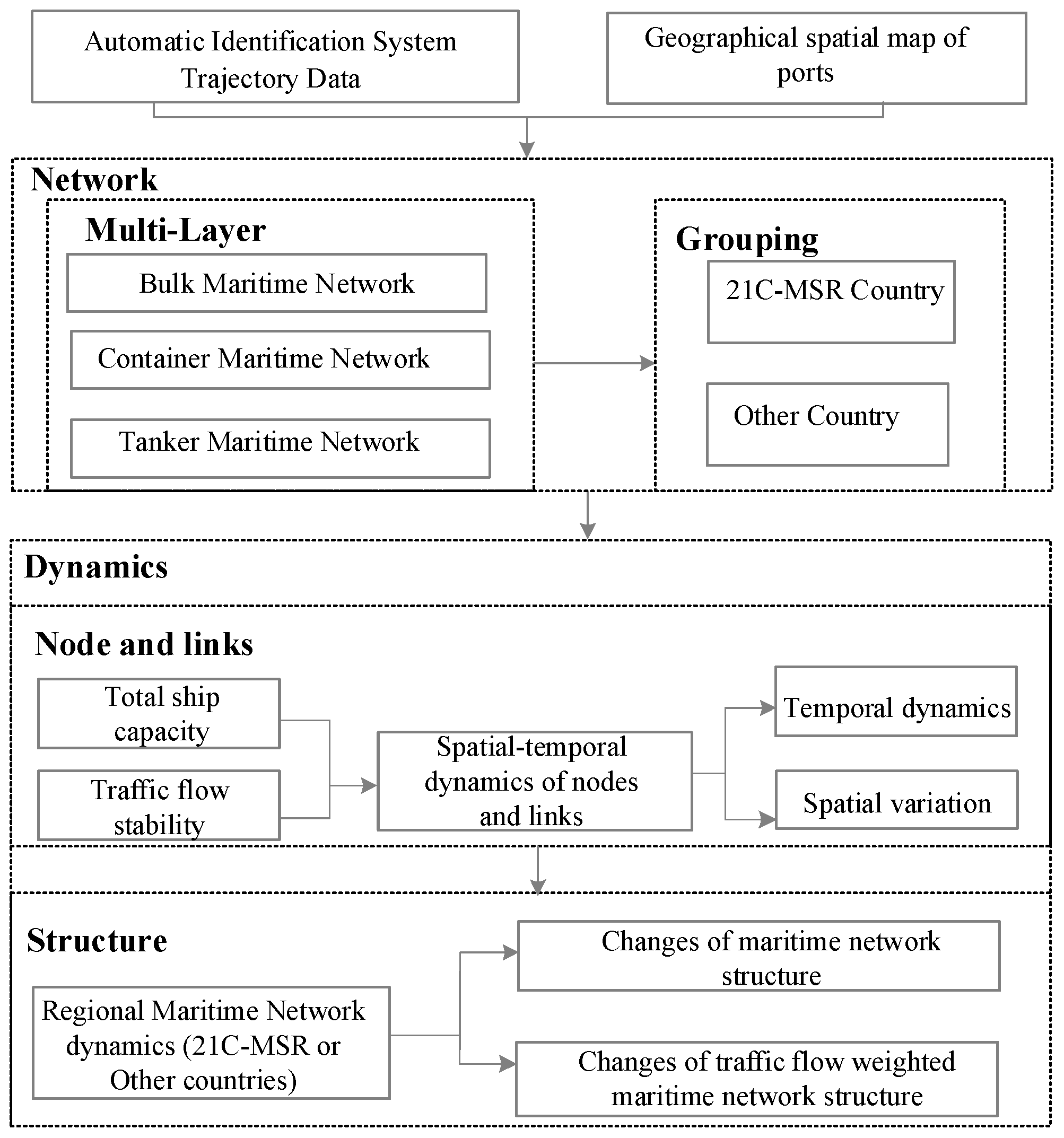


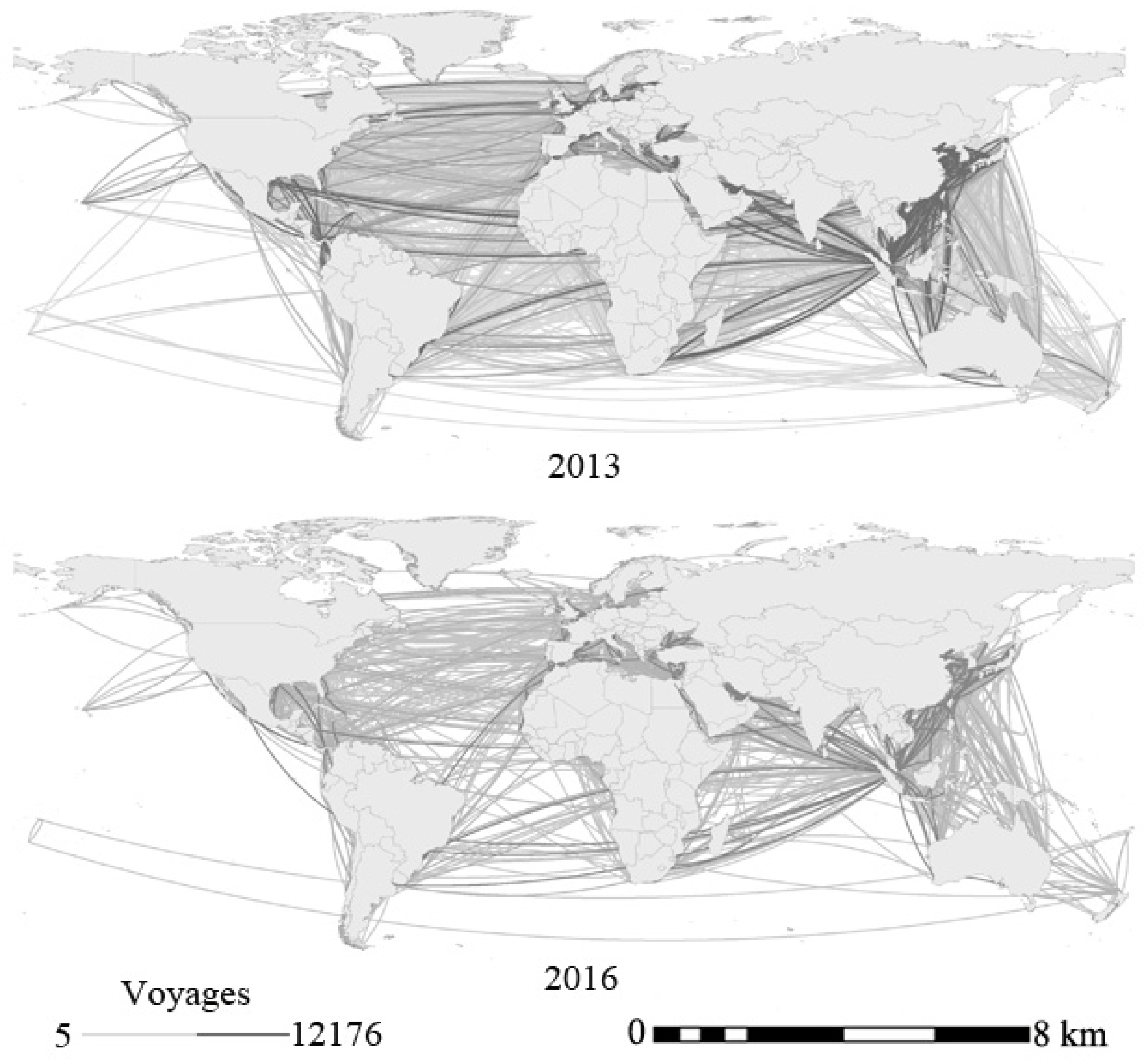
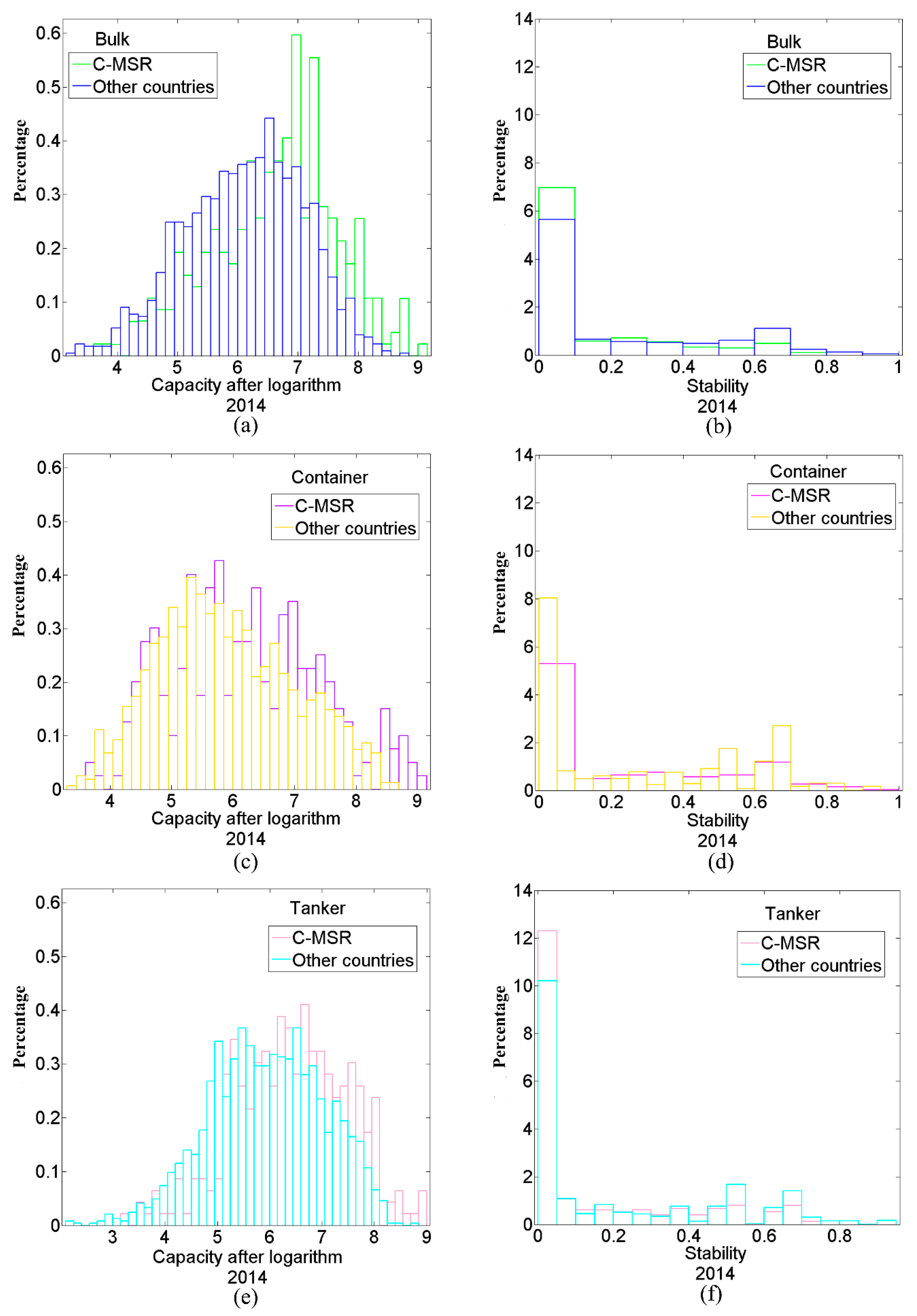
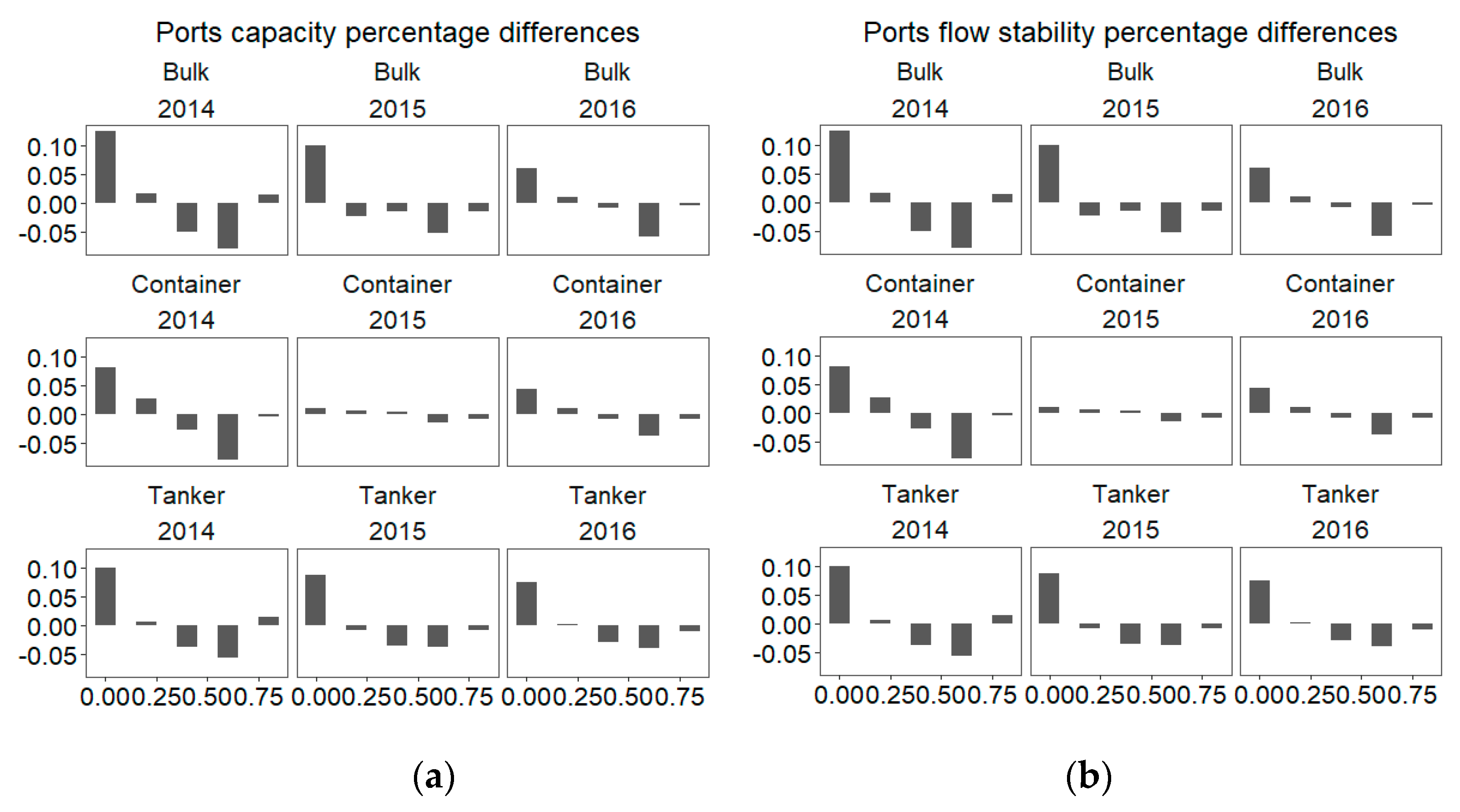
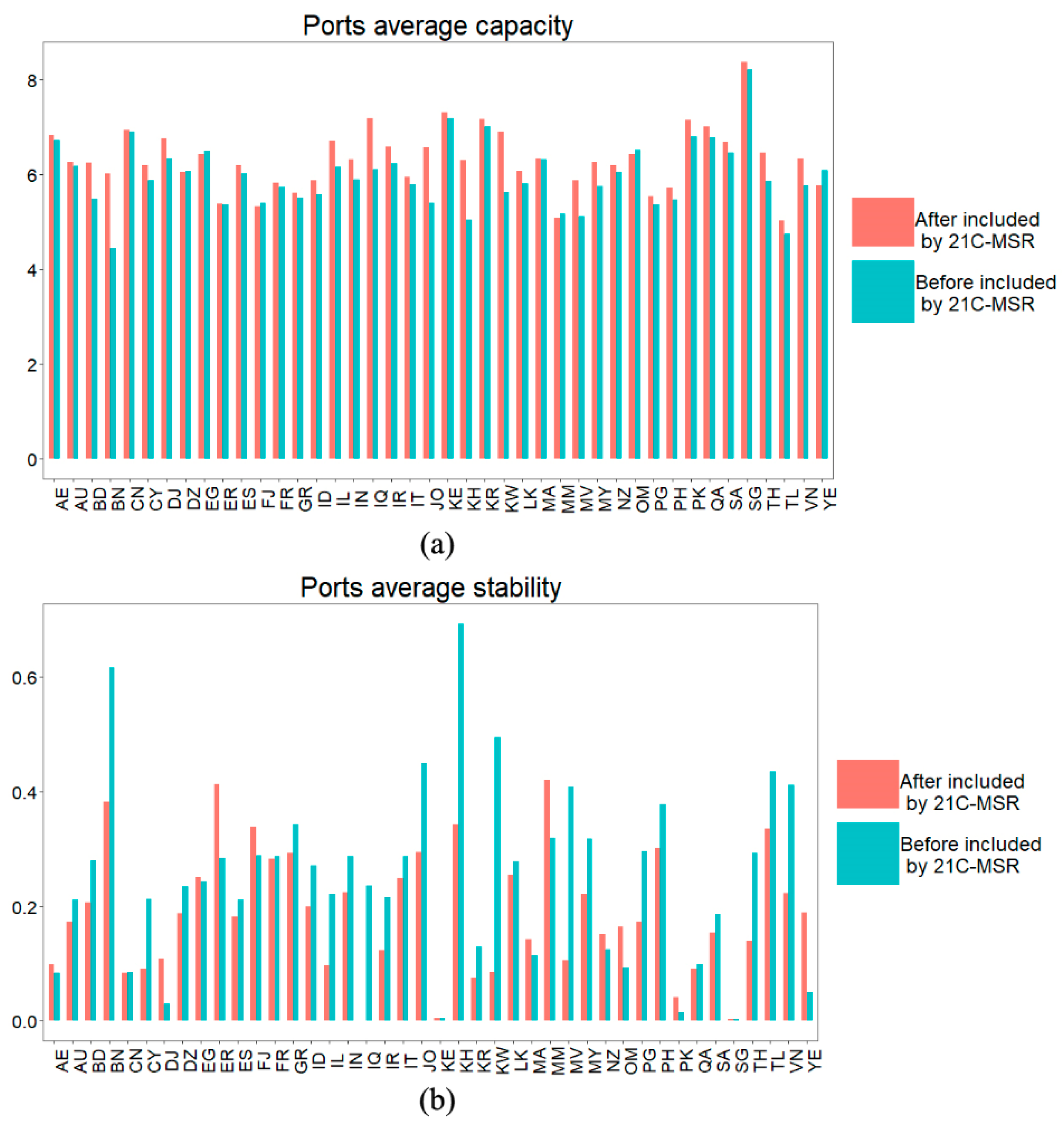
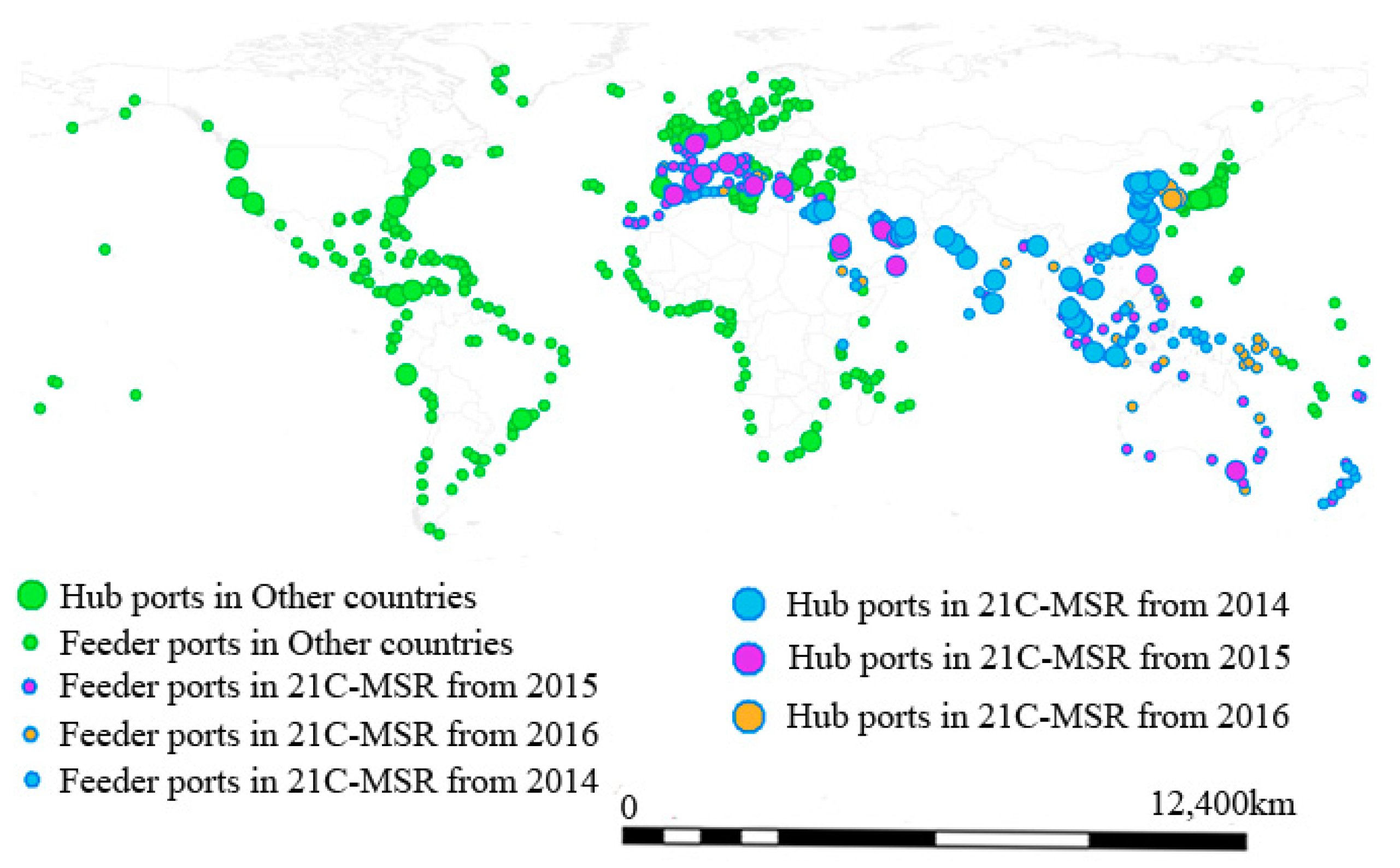

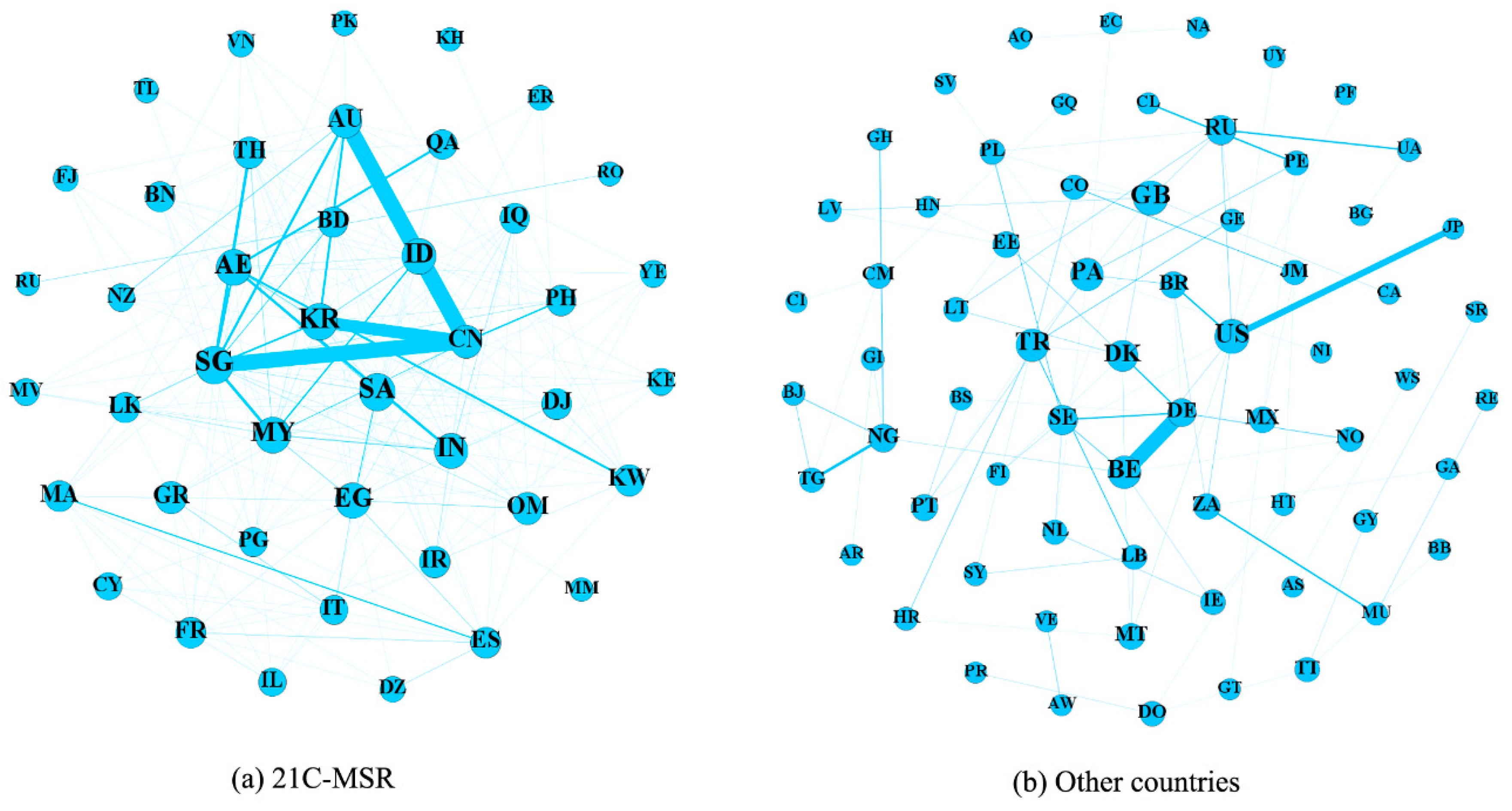
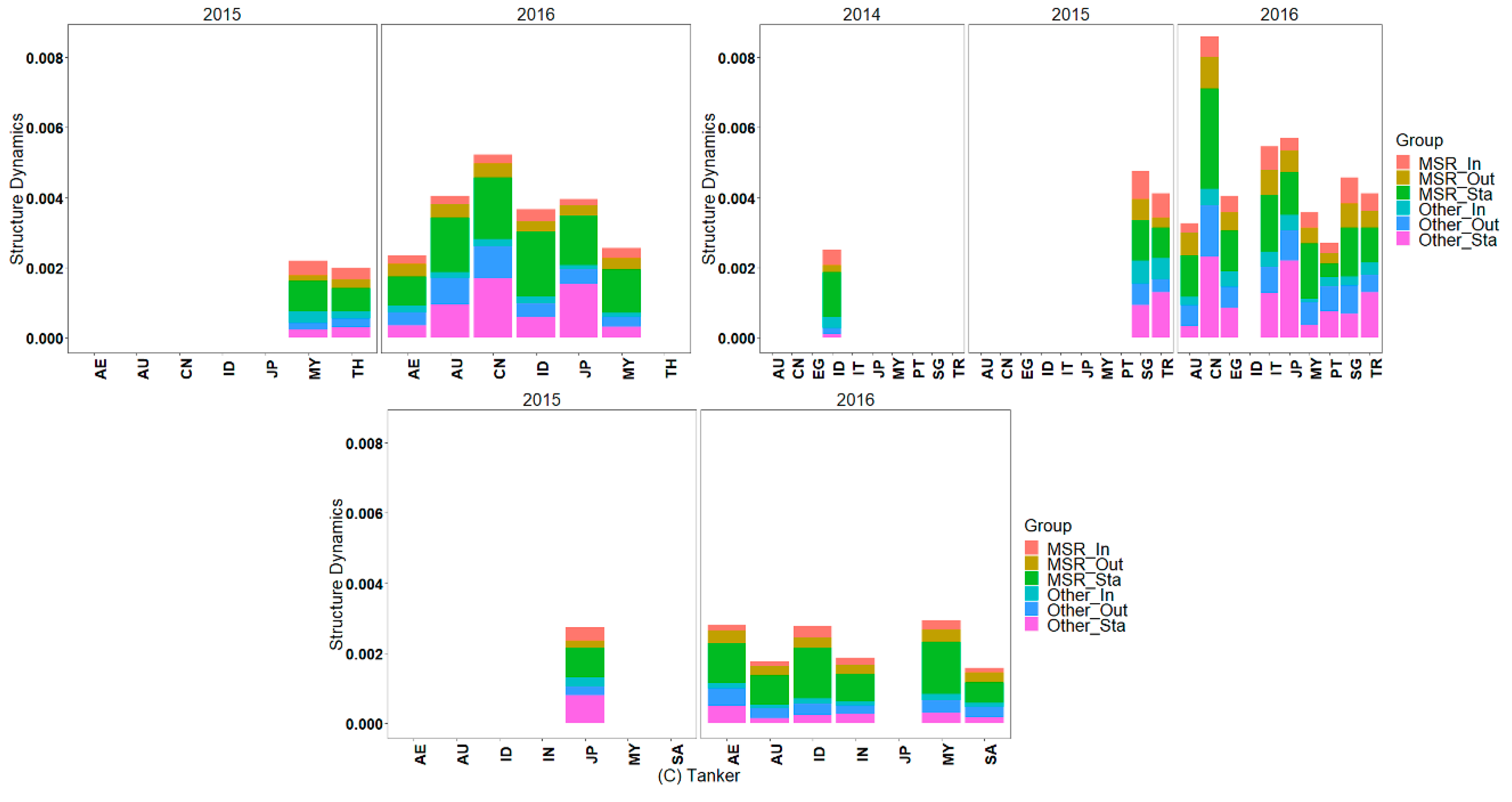
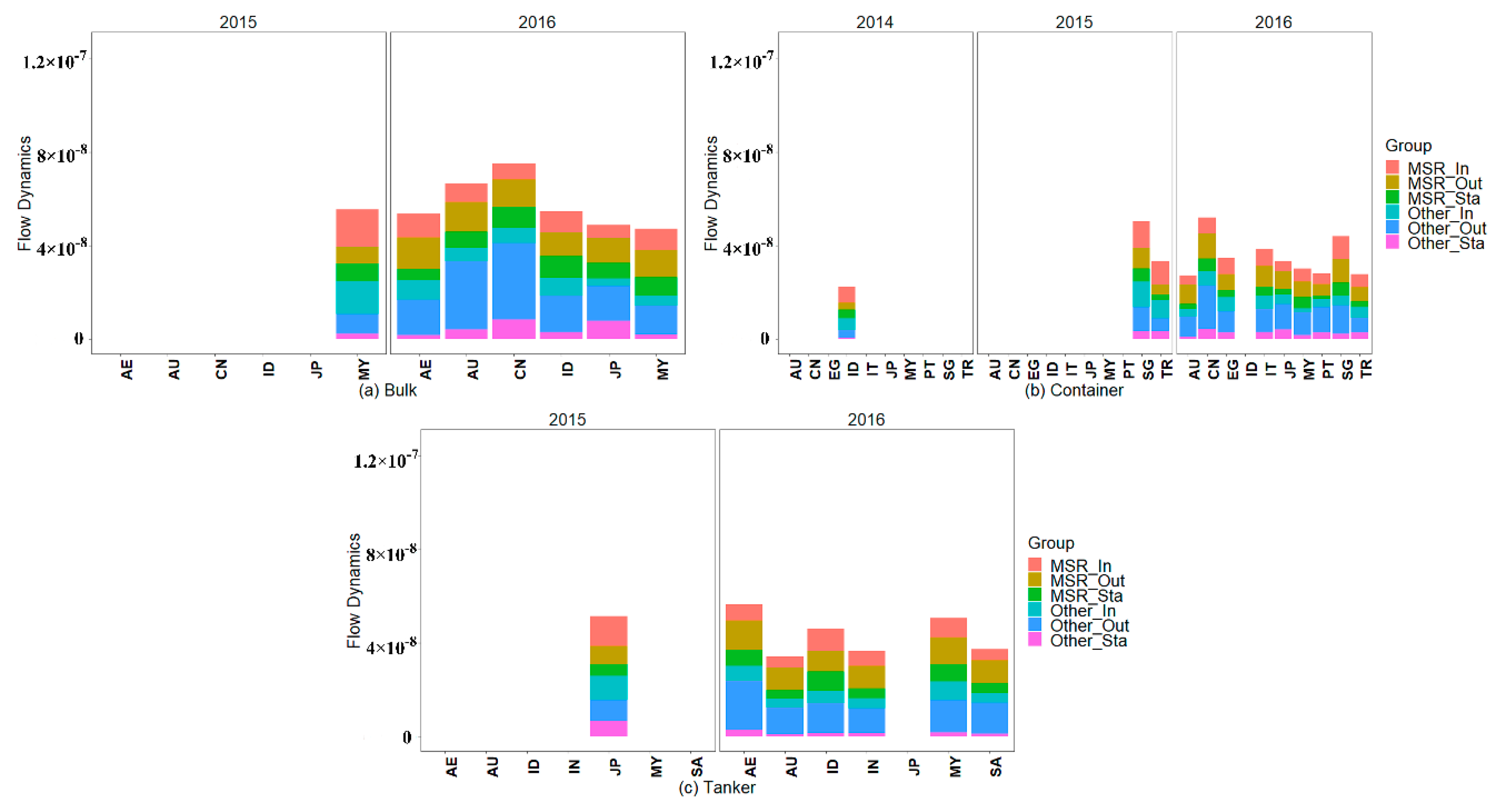
| Reference | Focus | Network Types | Indicators | Other Methods | Area |
|---|---|---|---|---|---|
| Li et al. [12]; Ducruet and Notteboom [13]; Xu et al. [14] | Structure and evolution | Container | Number of nodes, path length, mean journeys; degree, centrality, weighted centrality, clustering coefficient, eccentricity, rich-club coefficient, modularity, beta index, gamma index, gini coefficient, comprehensive centrality | World | |
| Laxe et al. [15] | Structure and evolution | Container; | Sample of world fleet | ||
| Liu et al. [18]; Woolley-Meza et al. [19]; Lhomme [20] | Structure and spatial heterogeneity; Structure and robustness | Singer layer | World | ||
| Ducruet [2] | Structure and dynamics | Multilayer | World | ||
| Zhao et al. [32]; Caschili et al. [33] | Structure | Container; | Sample of world fleet | ||
| Ducruet [24] | Structure and diversity | Multilayer | world | ||
| Kaluza et al. [23] | Structure | Multilayer | Gravity model | Sample of world fleet | |
| Tsiotas and Polyzos [34] | Structure and node aggregation | Tourism | Greece | ||
| Ducruet et al. [35] | Structure | container | East Asia | ||
| Kosowska-Stamirowska et al. [16] | Structure and evolution | Trade | Random walk | world | |
| Liu et al. [21]; Calatayud et al. [22] | Structure and robustness | Container | Borda count | Maersk shipping line; Americas | |
| Peng et al. [25] | Structure and robustness | Multilayer | world | ||
| Peng et al. [17] | Structure and evolution | Crude oil | world | ||
| Yu et al. [11] | Structure | Trade | Linkage intensity, linkage tightness, spatial isolation index, linkage concentration index | China |
| Item | Meaning |
|---|---|
| Maritime Mobile Service Identity (MMSI) | Unique ID for the vessel |
| Start Time (Ship entering the port)/End Time (Ship leaving the port) | Second-level timestamp (e.g., 2015-06-10 01:16:58) |
| ship’s Location | Longitude and latitude of the ship location |
| Vessel_type | Type of vessel (bulk/container/tanker) |
| Vessel_name | Name of the vessel |
| Grosstone | Gross tonnage of the vessel |
| Length | Length of the vessel |
| Width | Width of the vessel |
| Draft | Draft of the vessel |
| Deadweight | Dead Weight of the vessel |
| Type | Number | Average Increased Capacity | Main Countries |
|---|---|---|---|
| Bulk links with continuously increasing capacity in 21C-MSR. | 345 | 3,125,407.29 | AU, CN, ID, KR, SG |
| Bulk links with continuously increasing capacity in other countries. | 236 | 1,243,252.48 | Canada (CA), Ukraine(UA), United States (US) |
| Tanker links with continuously increasing capacity in 21C-MSR. | 448 | 1,696,798.74 | AE,CN, KR, KW, SG |
| Tanker links with continuously increasing capacity in other countries | 450 | 1,408,144.76 | Belgium(BE), Denmark(DK), United Kingdom(GB), the Netherlands (NL), Panama(PA), Sweden (SE), US |
| Type | Number | Average Increased Capacity | Main Countries |
|---|---|---|---|
| Container links with continuously increasing volume in 21C-MSR | 388 | 3,524,387.11 | CN, KR, MY, SG, TH |
| Container links with continuously increasing volume in other countries | 250 | 2,320,540.44 | CA,GB, NL, PA |
© 2019 by the authors. Licensee MDPI, Basel, Switzerland. This article is an open access article distributed under the terms and conditions of the Creative Commons Attribution (CC BY) license (http://creativecommons.org/licenses/by/4.0/).
Share and Cite
Yu, H.; Fang, Z.; Lu, F.; Murray, A.T.; Zhao, Z.; Xu, Y.; Yang, X. Massive Automatic Identification System Sensor Trajectory Data-Based Multi-Layer Linkage Network Dynamics of Maritime Transport along 21st-Century Maritime Silk Road. Sensors 2019, 19, 4197. https://doi.org/10.3390/s19194197
Yu H, Fang Z, Lu F, Murray AT, Zhao Z, Xu Y, Yang X. Massive Automatic Identification System Sensor Trajectory Data-Based Multi-Layer Linkage Network Dynamics of Maritime Transport along 21st-Century Maritime Silk Road. Sensors. 2019; 19(19):4197. https://doi.org/10.3390/s19194197
Chicago/Turabian StyleYu, Hongchu, Zhixiang Fang, Feng Lu, Alan T. Murray, Zhiyuan Zhao, Yang Xu, and Xiping Yang. 2019. "Massive Automatic Identification System Sensor Trajectory Data-Based Multi-Layer Linkage Network Dynamics of Maritime Transport along 21st-Century Maritime Silk Road" Sensors 19, no. 19: 4197. https://doi.org/10.3390/s19194197
APA StyleYu, H., Fang, Z., Lu, F., Murray, A. T., Zhao, Z., Xu, Y., & Yang, X. (2019). Massive Automatic Identification System Sensor Trajectory Data-Based Multi-Layer Linkage Network Dynamics of Maritime Transport along 21st-Century Maritime Silk Road. Sensors, 19(19), 4197. https://doi.org/10.3390/s19194197








